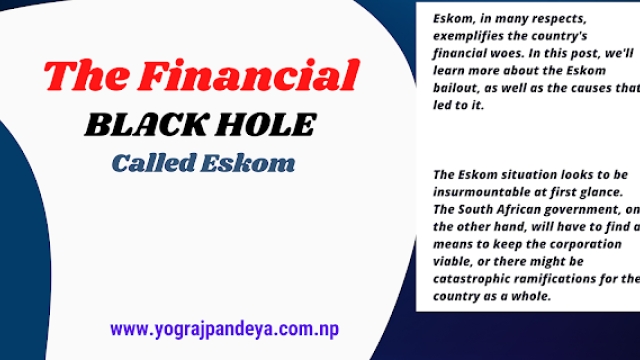The Financial Black Hole Called Eskom
South Africa’s financial troubles are now well-known across the world. However, few people are aware of Eskom, a South African company that is threatening to plunge the country into a catastrophic financial catastrophe. The South African government was compelled to grant it a $500 million bailout at the last minute, bringing this state-owned utility into the spotlight.
Eskom, in many respects, exemplifies the country’s financial woes. In this post, we’ll learn more about the Eskom bailout, as well as the causes that led to it.
Why Did the South African Government Bailout Eskom?
Because all of Eskom’s obligations are guaranteed by the South African government, the South African government was compelled to bail out Eskom. As a result, if Eskom defaults, investors will immediately turn to the South African government to collect their dues. The South African government’s resources are already stretched thin, and it cannot afford to repay Eskom’s creditors.
Eskom is attempting to reduce its reliance on the South African government. It had made agreements with a Chinese bank and was expected to receive a $500 million tranche of the $2.5 billion loans that the two parties had agreed on. The Chinese central bank, on the other hand, modified several criteria, postponing the transfer of $500 million to Eskom. This brought to light the company’s dire financial state.
Eskom has no means of paying its payments in the absence of the Chinese loan. As a result, it was on the verge of declaring bankruptcy. This is why, to avert a disaster, the South African government, which is the guarantee of Eskom’s loans, had to secure emergency funds.
What Does Eskom’s Financial Future Look Like?
By securing emergency funds for the debt-ridden corporation, the South African government may have saved the day. However, it does not appear like the South African firm will be able to stay in business for long. For example, the corporation is forecasting an R30 billion deficit for the fiscal year ending in 2019. Eskom will have no choice but to increase its borrowing to cover the gap. This will increase the total debt, worsening the situation.
In the long term, there is only one way for Eskom to overcome its problems: by boosting income. This is why the loss-making corporation has approached the South African government with a plan to allow it to boost prices. The corporation plans to hike prices by 15% per year for the following three years to boost income significantly.
However, the South African government cannot allow this to happen since it would result in a 50 percent increase in power prices in three years, sparking widespread public uproar. As a result, the South African government has agreed to a meager 5% increase for the next three years, which is insufficient to avert the financial crisis.
Real Measures Being Avoided
When it comes to resolving the Eskom crisis, there is a lot of politics at play. For example, it is well known that Eskom’s personnel is overpaid. If the corporation could merely lay off some of the many superfluous people who are now a part of the company, it might save billions of dollars in cash flow. President Cyril Ramaphosa, on the other hand, is up for re-election in the coming months. As a result, even if it makes perfect economic sense, he is unlikely to take any controversial steps.
This is why Ramaphosa has resorted to political gimmicks like a diversion. The debt-ridden firm Eskom would be divided into three pieces, according to the latest proposal suggested by the South African government. It’s unclear how breaking up the business will help fix the problem. Will the government also eliminate positions that are no longer needed? Will the government sell the corporation to lower the national debt? To buy time before the national election, the answers to these issues have been purposefully buried. The reality is that unless the fundamental issues are addressed, Eskom will remain bankrupt, whether it is divided into three pieces or three hundred.
Why was The Collapse of Eskom Could Be Catastrophic?
Eskom is South Africa’s sole electricity provider. Electricity is a critical commodity that is critical to the economy’s overall health. The South African administration, as well as the South African people, are desperate to avert a blackout such as that experienced in Venezuela. This is why the government gave Eskom an R6 billion loan to avert load shedding. Eskom’s operations, on the other hand, are in such terrible form that they were unable to prevent load shedding, and the entire country was subjected to lengthy periods of Grade 4 load shedding.
The Eskom situation looks to be insurmountable at first glance. The South African government, on the other hand, will have to find a means to keep the corporation viable, or there might be catastrophic ramifications for the country as a whole.
More:
- 1. Does Financial Innovation Benefit the Society?
- 2. What is Financial Modeling and What Purpose does it serve in the BFSI Sector?
- 3. Want to Become a Financial Professional? Read on for Some Tips on How You Prepare
- 4. Aspiring for a Career in Finance? Here Are Some Things that Would Help You Prepare
- 5. Why Financial Innovation can be both a Force for Good and Bad?
- 6. Role of the Finance Function in the Financial Management for Corporates
- 7. Financial Intermediaries – Meaning, Role and Its Importance
- 8. 7 Modern Financial Management Techniques that Will Change Your Business
- 9. Profit Maximization Criticisms
- 10. Financial Goal – Profit vs Wealth
- 11. Capitalization in Finance
- 12. Capital Structure – Meaning and Factors Determining Capital Structure
- 13. Role of a Financial Manager
- 14. The Role of the Finance Function in Organizational Processes
- 15. Finance Functions
- 16. Financial Planning – Definition, Objectives and Importance
- 17. Financial Management – Meaning, Objectives, and Functions


